Main menu
Common skin conditions

NEWS
Join DermNet PRO
Read more
Quick links
Created 2009.
An exanthem is a widespread erythematous rash that is accompanied by systemic symptoms such as fever, headache and malaise. Exanthems during childhood are usually associated with viral infection and represent either a reaction to a toxin produced by the organism, damage to the skin by the organism, or an immune response.
The causative viruses for chickenpox (varicella), measles (morbilli), rubella, roseola, fifth disease (erythema infectiosum), hand foot and mouth disease, and smallpox (hopefully now eradicated) are known and result in distinctive patterns of rashes and prodromal symptoms.
When there are no characteristic lesions and distinctive prodromal signs and symptoms, diagnosis of a specific cause may not be possible. Many exanthems are associated with common winter and summer viruses including respiratory and enteroviruses. It becomes more important to make a definitive diagnosis if the child has been exposed to pregnant women or immunocompromised patients.
Exanthems may also be due to bacterial toxins.
Drug eruptions can also result in a wide range of similar presentations, including morbilliform and pityriasis rosea-like rashes.
Chickenpox (primary herpes varicella/zoster infection) is characterised by mild systemic symptoms and few or many pruritic papules, vesicles, pustules and crusted lesions. These are found predominantly on the face and trunk. Scars arise from full-thickness lesions.
Chickenpox Close-up of vesicles Lesions at differing stages Varicella scars 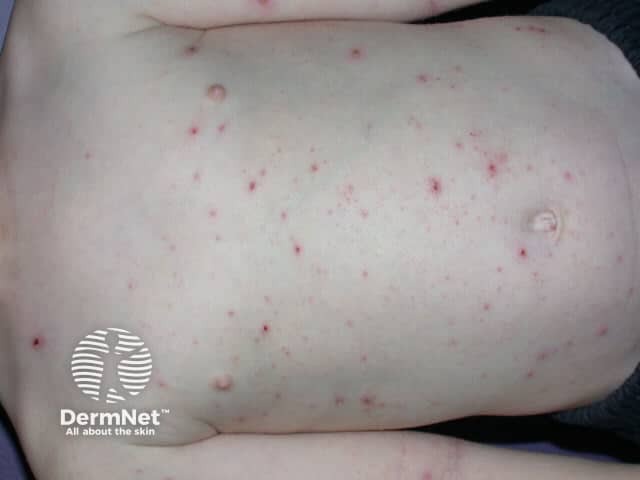

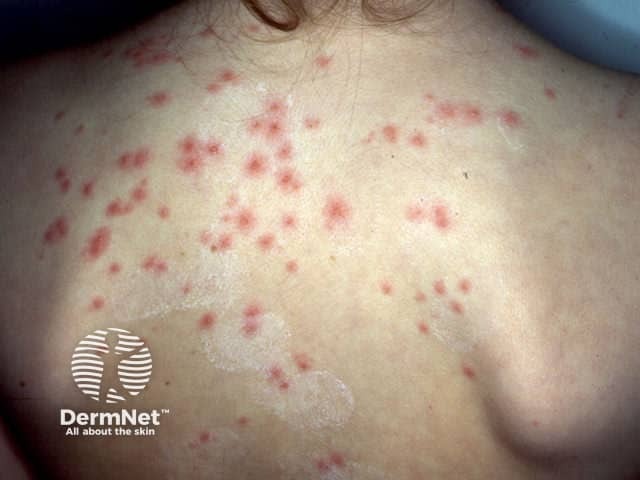
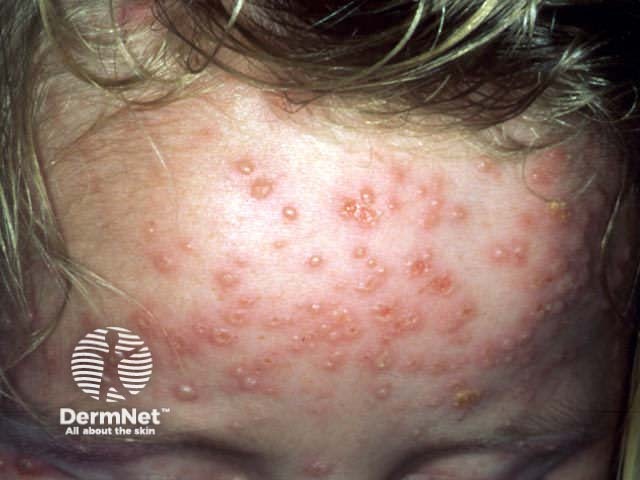
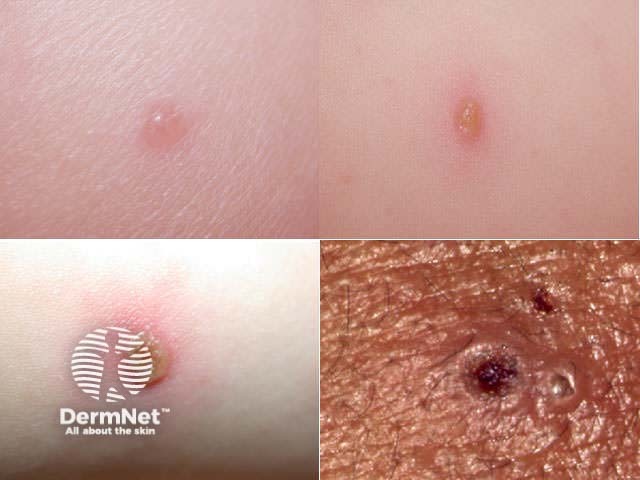
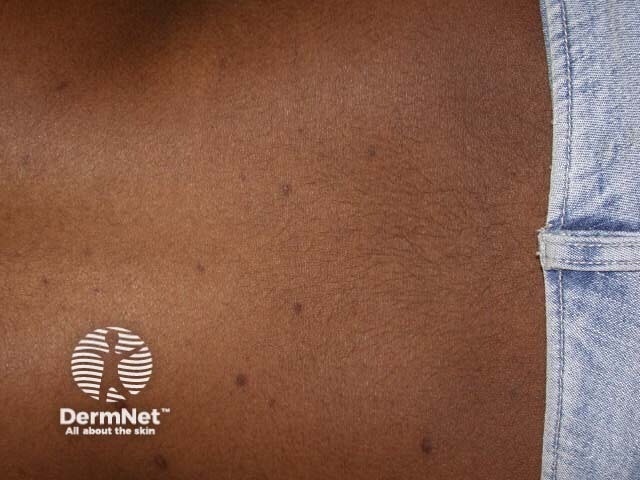
The virus is highly contagious from 1to 2 days before the rash appears and until all the blisters have formed scabs. It is spread by airborne respiratory droplets or through direct contact with blister fluid. The incubation period is 10 to 21 days.
The rash is associated with moderate to high fever, headache, upper respiratory symptoms, vomiting and diarrhoea. Most adults who get chickenpox experience prodromal symptoms for up to 48 hours. Complications are more common in adults and include streptococcal cellulitis, central nervous system infection, thrombocytopenia and pneumonia.
Exposure to varicella virus during pregnancy may cause viral pneumonia, premature labour and rarely maternal death. Approximately 25% of fetuses become infected and may remain asymptomatic, or develop herpes zoster at a young age without a previous history of primary chickenpox infection.
Consider prescribing oral aciclovir (antiviral agent) in those older than 12 years or immunocompromised patients. In cases of inadvertent exposure to the virus, varicella-zoster immune globulin if given within 96 hours of initial contact can reduce the severity of the disease though not prevent it.
Vaccination with live attenuated varicella vaccine is effective, but this is currently not part of the immunisation programme for children in New Zealand.
Measles (morbilli, rubeola) still causes more than a million childhood deaths each year in undeveloped countries. In New Zealand the risk of developing measles is low.
Measles is highly contagious from 2 days before symptoms to at least five days after the onset of rash. It is spread by airborne droplets. The incubation period ranges from 7-14 days.
The prodrome includes fever, malaise, anorexia, followed by conjunctivitis (red eyes), cough and coryza. Two or three days into the prodrome phase, Koplik spots (oral papules) appear, followed 24-48 later by the exanthem. The rash commences on the cheeks and spreads a day or so later to the trunk and limbs as widespread ‘morbilliform’ erythema (5-10mm macules). It fades within a few days and may be followed by light scaling. A cough may persist for 1-3 weeks.
Morbilli exanthem Morbilli exanthem Koplik spots 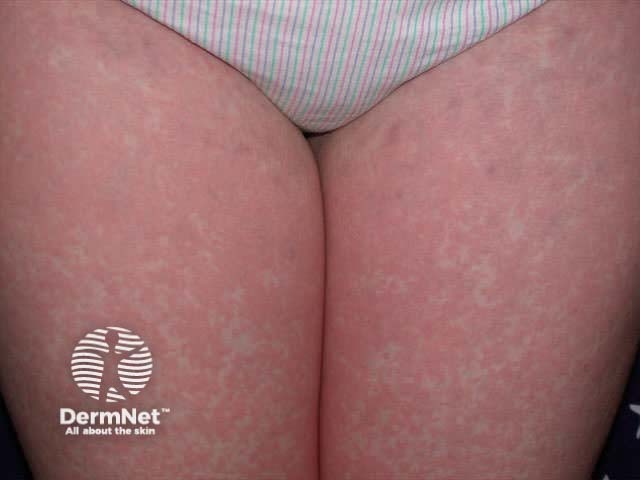
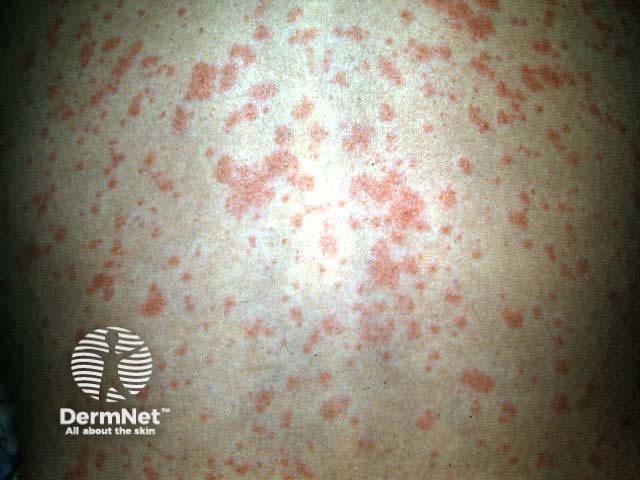
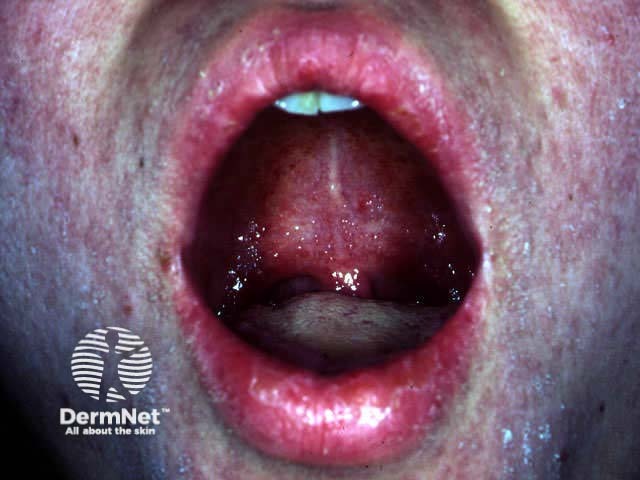
Measles-associated complications include otitis media, corneal ulceration enteropathy, glomerulonephritis, pneumonia and sepsis.
Infection during pregnancy increases the risk of premature labour and delivery, and fetal loss. There is also a risk of maternal death.
Measles can be prevented by vaccination with live attenuated measles vaccine. It is available as a single antigen preparation or combined with live attenuated mumps or rubella vaccines, or both. Combined measles, mumps and rubella (MMR) vaccine is currently part of routine immunisation programmes in most industrialised countries, including New Zealand. The first dose is at 12-15 months, followed by a second dose at 4-6 years. Individuals vaccinated before 1968 may require revaccination as vaccines used before this time may not have conferred life-long immunity.
Rubella (German measles) is a mild febrile illness associated with lymphadenopathy and pale pink erythema. Congenital rubella infection results in major birth deformities hence females at least should be vaccinated in adolescence.
Rubella is spread through direct contact with nasal or throat secretions. An infected person is contagious from 7 days before the rash appearing until seven days later. The incubation period is between 12-23 days.
In 25-50%, rubella is asymptomatic. Common symptoms include slight fever, sore throat, rhinitis and malaise. The pale pink erythematous rash begins on the face that spreads to the neck, trunk and extremities. It lasts up to 5 days and may be followed by light scaling. It is associated with postauricular and cervical lymphadenopathy, and arthralgia or arthritis in adults, which sometimes persists for months or years.
Rubella exanthem 
Rubella virus can be isolated from throat swabs, blood, urine and spinal fluid.
Complications are rare with rubella in healthy infants and adults but infection in the first trimester of pregnancy has a 50% chance of causing miscarriage, stillbirth or congenital rubella syndrome.
Combined measles, mumps and rubella (MMR) vaccine is currently part of routine immunisation programmes in most industrialised countries, including New Zealand. Rubella vaccine induces long-term (probably life-long) immunity in most individuals. Vaccination schedules recommend a two-dose immunisation strategy, the first dose at 12-15 months, followed by a second dose at 4-6 years.
Roseola infantum (erythema subitum) is due to herpesvirus 6, which may also be asymptomatic, and possibly also by type 7.
Roseola is most commonly seen in children between 6 months and three years of age. It is characterised by high fever lasting for 3-5 days, rhinitis, cough, irritability and tiredness. As the fever subsides, a mild toxic erythema may appear on the face and trunk and persists for 1 to 3 days.
Roseola is spread via respiratory droplets during the febrile phase of the illness. The incubation period for roseola is approximately 9-10 days after exposure.
Febrile seizures/convulsions may occur in 5-15% of infected children. Encephalitis and hepatitis are rare.
Fifth disease (erythema infectiosum) is due to parvovirus B19 and most commonly affects young children. It often occurs in several members of the family or school class.
About 30% of infections are asymptomatic. The child is usually otherwise quite well but occasionally has a slight fever and headache. Fifth disease is characterised by burning red swollen ‘slapped’ cheeks followed by evanescent lacy-pattern erythema on the limbs and trunk 1 to 4 days later. Although most prominent in the first few days, the rash can persist at least intermittently for up to six weeks.
Parvovirus occasionally results in erythema in a glove-and-stocking pattern.
Fifth disease Fifth disease 
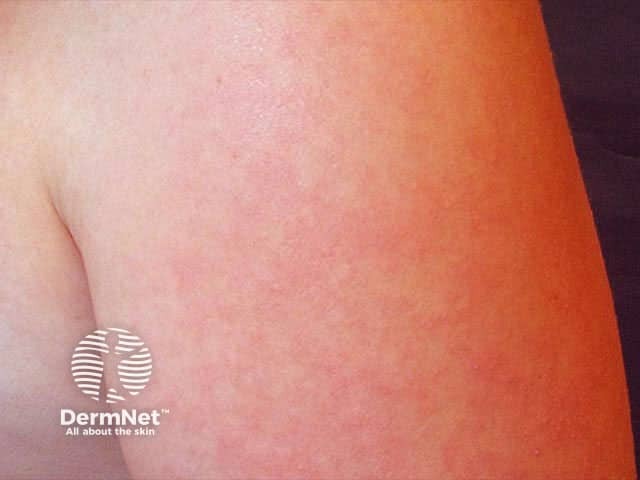
It may cause arthralgia in adults and rarely aplastic crises. Congenital infection in the first or second trimester may result in fetal hydrops (3%), anaemia and intrauterine death (9%) but it does not result in congenital malformations.
Hand, foot and mouth disease is a common, very infectious, mild and short-lasting condition most often affecting young children during the summer months. It is usually due to Coxsackievirus A16, although it can also be due to Enterovirus 71.
After an incubation period of 3 to 5 days, small flat blisters appear on the hands and feet, and painful ulcers appear in the mouth. There may be a mild fever. Sometimes in young children, there is a rash on the buttocks.
Hand, foot and mouth disease Hand, foot and mouth disease 

Describe the standard New Zealand immunisation schedule.
Information for patients
See the DermNet bookstore.